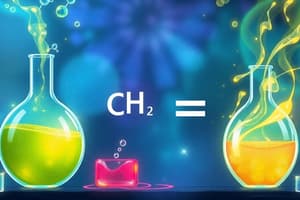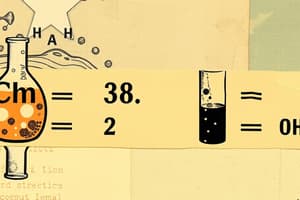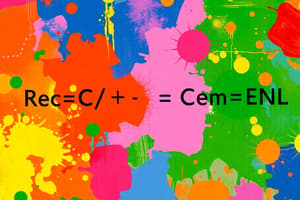Podcast
Questions and Answers
What is the significance of coefficients in a balanced chemical equation?
What is the significance of coefficients in a balanced chemical equation?
Coefficients indicate the mole ratios of reactants and products, crucial for stoichiometric calculations.
Explain how to convert a word equation into a skeleton equation.
Explain how to convert a word equation into a skeleton equation.
Replace the chemical names with their respective symbols and formulas, omitting any quantitative information.
How do you identify a decomposition reaction?
How do you identify a decomposition reaction?
A single compound breaks down into two or more simpler substances.
What role does the law of conservation of mass play in balancing chemical equations?
What role does the law of conservation of mass play in balancing chemical equations?
Explain the difference between a skeleton equation and a balanced equation.
Explain the difference between a skeleton equation and a balanced equation.
How can you tell if a reaction is a single-replacement reaction?
How can you tell if a reaction is a single-replacement reaction?
Describe what is meant by the term 'aqueous solution,' and how is it denoted in a chemical equation?
Describe what is meant by the term 'aqueous solution,' and how is it denoted in a chemical equation?
Explain how a catalyst is indicated in a chemical equation.
Explain how a catalyst is indicated in a chemical equation.
How do combination (synthesis) reactions differ from decomposition reactions?
How do combination (synthesis) reactions differ from decomposition reactions?
What are the typical products of a combustion reaction?
What are the typical products of a combustion reaction?
Explain why the law of conservation of mass is crucial in stoichiometry.
Explain why the law of conservation of mass is crucial in stoichiometry.
Describe how to determine the mole ratio between two substances in a balanced chemical equation.
Describe how to determine the mole ratio between two substances in a balanced chemical equation.
How do you convert from grams of a substance to moles of that substance?
How do you convert from grams of a substance to moles of that substance?
Explain the steps involved in performing a mass-mass stoichiometric calculation.
Explain the steps involved in performing a mass-mass stoichiometric calculation.
What is the significance of balancing chemical equations before performing stoichiometric calculations?
What is the significance of balancing chemical equations before performing stoichiometric calculations?
What is a 'limiting reagent,' and why is it important in chemical reactions?
What is a 'limiting reagent,' and why is it important in chemical reactions?
Explain the difference between 'limiting reactant' and 'excess reactant.'
Explain the difference between 'limiting reactant' and 'excess reactant.'
How do you determine which reactant is the limiting reagent in a chemical reaction?
How do you determine which reactant is the limiting reagent in a chemical reaction?
Why is it necessary to convert the mass of reactants to moles before determining the limiting reagent?
Why is it necessary to convert the mass of reactants to moles before determining the limiting reagent?
If you know the mass of the limiting reagent, how do you calculate the maximum mass of product formed?
If you know the mass of the limiting reagent, how do you calculate the maximum mass of product formed?
Define 'theoretical yield' and 'actual yield.'
Define 'theoretical yield' and 'actual yield.'
What is 'percent yield,' and why is it useful?
What is 'percent yield,' and why is it useful?
How would you calculate the percent yield of a reaction if you know the actual yield and the amount of limiting reagent used?
How would you calculate the percent yield of a reaction if you know the actual yield and the amount of limiting reagent used?
What factors can cause the actual yield of a reaction to be less than the theoretical yield?
What factors can cause the actual yield of a reaction to be less than the theoretical yield?
Can the actual yield of a reaction ever be greater than the theoretical yield? Explain.
Can the actual yield of a reaction ever be greater than the theoretical yield? Explain.
Given the balanced equation $\text{N}_2(g) + 3\text{H}_2(g) \rightarrow 2\text{NH}_3(g)$, explain the quantities that this equation defines regarding reactants and products.
Given the balanced equation $\text{N}_2(g) + 3\text{H}_2(g) \rightarrow 2\text{NH}_3(g)$, explain the quantities that this equation defines regarding reactants and products.
Explain the role of the arrow ($\rightarrow$) in a chemical equation.
Explain the role of the arrow ($\rightarrow$) in a chemical equation.
Describe the information provided by the physical state symbols (s, l, g, aq) in a chemical equation.
Describe the information provided by the physical state symbols (s, l, g, aq) in a chemical equation.
Explain the role of the '+' sign on either side of the arrow in a chemical equation.
Explain the role of the '+' sign on either side of the arrow in a chemical equation.
Given the reaction $2H_2(g) + O_2(g) \rightarrow 2H_2O(l)$, describe how to interpret this equation in terms of molecules.
Given the reaction $2H_2(g) + O_2(g) \rightarrow 2H_2O(l)$, describe how to interpret this equation in terms of molecules.
How does the concept of a 'mole ratio' apply when converting moles of a given reactant to moles of desired product?
How does the concept of a 'mole ratio' apply when converting moles of a given reactant to moles of desired product?
Explain how to identify whether heat is supplied to a reaction, based only on it's chemical equation.
Explain how to identify whether heat is supplied to a reaction, based only on it's chemical equation.
Explain the difference between 'interpreting' and 'balancing' a chemical equation.
Explain the difference between 'interpreting' and 'balancing' a chemical equation.
Explain why it is important to use the balanced chemical equation when determining the limiting reagent, and not the skeleton equation?
Explain why it is important to use the balanced chemical equation when determining the limiting reagent, and not the skeleton equation?
Consider the decomposition of water: $2 H_2O (l) \rightarrow 2 H_2 (g) + O_2 (g)$. Could you design an experiment to determine the actual yield of oxygen gas in this process, and what measurements would you take?
Consider the decomposition of water: $2 H_2O (l) \rightarrow 2 H_2 (g) + O_2 (g)$. Could you design an experiment to determine the actual yield of oxygen gas in this process, and what measurements would you take?
Explain the difference between interpreting a chemical reaction in terms of molecules and moles.
Explain the difference between interpreting a chemical reaction in terms of molecules and moles.
Explain how the balanced chemical equation can be viewed as a "recipe," providing a ratio of all reactants and products.
Explain how the balanced chemical equation can be viewed as a "recipe," providing a ratio of all reactants and products.
Explain the importance of including state symbols $(s, l, g, aq)$ in a balanced chemical equation.
Explain the importance of including state symbols $(s, l, g, aq)$ in a balanced chemical equation.
Describe a situation where the limiting reactant is industrially useful.
Describe a situation where the limiting reactant is industrially useful.
Flashcards
Reactants
Reactants
Substances present before a chemical reaction.
Products
Products
Substances present after a chemical reaction.
Word Equation
Word Equation
Equation using full names of elements/compounds to describe a reaction.
Skeleton Equation
Skeleton Equation
Signup and view all the flashcards
Skeleton equation
Skeleton equation
Signup and view all the flashcards
Law of Conservation of Mass
Law of Conservation of Mass
Signup and view all the flashcards
Coefficients
Coefficients
Signup and view all the flashcards
Combination (Synthesis) Reaction
Combination (Synthesis) Reaction
Signup and view all the flashcards
Decomposition reaction
Decomposition reaction
Signup and view all the flashcards
Single-Replacement Reaction
Single-Replacement Reaction
Signup and view all the flashcards
Double-Replacement Reaction
Double-Replacement Reaction
Signup and view all the flashcards
Combustion reaction
Combustion reaction
Signup and view all the flashcards
Hydrocarbon
Hydrocarbon
Signup and view all the flashcards
Mole Ratio
Mole Ratio
Signup and view all the flashcards
Limiting Reagent
Limiting Reagent
Signup and view all the flashcards
Excess Reagent
Excess Reagent
Signup and view all the flashcards
Theoretical Yield
Theoretical Yield
Signup and view all the flashcards
Actual Yield
Actual Yield
Signup and view all the flashcards
Percent Yield
Percent Yield
Signup and view all the flashcards
Study Notes
Chemical Equations
- In chemical reactions, one or more substances transform into one or more different substances.
- Reactants presented before the reaction are on the left of the arrow, and products on the right.
- Word equations and drawings can model what occurs in a chemical reaction.
Representing Reactions Using Word Equations
- Utilizing a word equation is quicker to write and easier to discern than a sentence.
- Iron and oxygen reacting to produce iron(III) oxide is an example.
- The arrow in the word equation represents "yields," "gives," or "reacts to produce."
Using Drawings to Explain Word Equations
- Illustrated depiction of reaction that combines ingredients to make bread.
- Flour, eggs, milk, salt, baking powder, and oil react to produce bread.
Chemical Equations
- Chemical equations use chemical symbols instead of words, such as Fe instead of iron.
- Skeleton equations show the formulas of reactants and products but not their relative amounts.
- Chemical symbols describe reactants and products in a skeleton equation.
- A skeleton equation does not indicate the relative amounts of the reactants and products.
Word Equations
- The full names of elements and compounds describe the reactants and products.
- The reactants are written on the left side of the arrow, and the products are on the right side.
- Hydrogen and oxygen yields water can be expressed as a word equation.
Symbols Used in Chemical Equations
- Math equations simplify representing variable relationships, chemical equations simplify reactions.
- Symbols used in equations serve as shorthand for information about actions and properties.
-
- separates two reactants or two products
- → "Yields"; separates reactants from products
- ⇄ shows the reaction is reversible and can go in either direction
- (s), (I), (g) designates solid, liquid or gas state
- (aq) designates an aqueous solution
- Δ or heat indicates heat supplied to a reaction
- A formula above or below the yield sign indicates catalyst use; platinum (Pt) is an example
Decomposition Reactions
- Hydrogen peroxide decomposes into water and oxygen in a decomposition reaction.
- Hydrogen peroxide is the only reactant, potassium iodide acts as a catalyst.
- H2O2 → H2O + O2 is the chemical equation for the reaction
- Elephant's toothpaste is produced by adding liquid soap, for a dramatic effect.
Balancing Equations
- The law of conservation of mass states that matter is conserved during any chemical reaction.
- The mass of products equals the mass of reactants and atoms are just rearranged.
- Numbers in front of terms to balance equations are called coefficients.
- First, a skeleton equation is needed
Types of Reactions
- Models represent reactions and predict products.
- Reactions are classified into five types, other classification systems also exist.
- Combination (Synthesis) Reactions: Synthesis reactions combine two substances into one.
- Decomposition Reactions: Decomposition reactions break down one substance into two.
- During a Single-Replacement Reaction: single-replacement reaction one element replaces another in a compound.
- During double-Replacement Reaction: double-replacement reaction two reacting compounds exchange positive ions, forming two new compounds on the product side.
Combination Synthesis
- Synthesis reactions form a single new substance as products.
- Occurring between alkali metals and halogens, they form binary ionic compounds.
- Can involve two nonmetals, such as sulfure + oxygen, can react and form sulfur dioxide and sulfur trioxide.
- Magnesium atoms Magnesium combine with oxygen molecules in the air to form magnesium oxide.
Decomposition Reactions
- A decomposition reaction changes a single compound into two or more products.
- Products can be any combination of elements and compounds, making them hard to predict.
- Decomposition reactions of one reactant decompose into two or more products.
- Orange colored mercury(II) oxide is heated, it decomposes into its constituent elements: liquid mercury and gaseous oxygen.
Single-Replacement Reactions
- These reactions change a compound into two new products, an element and a compound.
- A piece of potassium dropped into water produces potassium hydroxide and hydrogen gas.
Double-Replacement Reactions
- Positive ions are exchanged between two compounds, generally in ionic aqueous solutions.
- Can form a gas, a molecular compound like water, or a precipitate in a precipitation reaction.
- Occurs when two soluble ionic compounds in aqueous solution combine and one of the products formed is an insoluble ionic compound.
Combustion Reactions
- Involve a compound reacting with oxygen, producing energy in the form of heat/light.
- Hydrocarbons are often the reactants.
- Methane(CH4) with oxygen is an example of a combustion reaction.
Equations as a Recipe
- Making a product requires having the necessary ingredients / parts in the proper ratios.
- Balanced equations are like recipes, telling you the ingredients and their ratios.
- The number of tricycles that 640 (FSW3 GP2 ) can make with 1280 Ppedals is an example
Interpreting Chemical Equations
- Balanced chemical equations provide the relative amounts of reactants and products.
- Allows quantification of reactants and products in moles, mass, volume, and number of atoms/molecules.
- Calculation of quantites in chemical reactions is called stoichiometry.
- In N2+3H2→ 2NH3(g): 1 molecule N2 + 3 molecules H₂ -> 2 molecules NH3.
What Is Conserved?
- Antoine Lavoisier discovered in 1789 that mass is neither created nor destroyed in a chemical reaction, otherwise known as the law of conservation of mass
- It means that atoms are neither created nor destroyed and only rearranged during reactions.
- The number of atoms and the total mass of the reactants and products are always the same
Proportionality of Reactants and Products
- Balanced equations are like recipes which can be used to calculate the moles, mass, volume, of reactants or products using balanced chemical equations.
- The coefficients provide the proper ratios, and stoichiometry tells you how to calculate the moles, mass, volume, or number of atoms or molecules of products or reactants.
- in the reaction N2(g) + 3H2(g) → 2NH3(g): two moles of ammonia are produced when one mole of nitrogen and three moles of hydrogen react.
Stoichiometric Calculations
- A mole is equal to 6.02 x 1023 representative particles.
- A mole ratio, a conversion factor derived from the coefficients of a balanced chemical equation interpreted in terms of moles.
- Mole ratios are used to convert between a given number of moles of a reactant/product.
- In N2(g)+3H2(g)→ 2NH3(g): the coefficients in the chemical equation can be written in terms of molar ratios between between any of the reactants and for products.
- Mole-mole calculations can convert from a given number of moles of one reactant or product ,to the moles of another reactant or product.
Mass-Mass Calculations
- Mass-Mass stoichimetric calculations are a conversion between a given mass of one product/reactant to the mess of another using relationships.
- First, convert from mass to moles using the mass/mole relationship; the use the molar ratios from the balance equation; and then the mass/mole relatiopship again
- This method can determine the mass of ammonia produced given a starting mass of nitrogen using N2(g)+3H2(g)→ 2NH3(g)
Limiting Reagent and Percent Yield
- In reactions, an insufficient amount of reagents will limit amount of product made.
- This reactant is called the limiting reagent.
- Any reactant not used up is the excess reagent.
Limiting and Excess Reagents
- In reactions, an insufficient amount of reagents will limit amount of product made and is the called the limiting reagent.
- Conversely, the chemical equation for the production of ammonia has to follow with the correct ratios for the reactants.
- Reaction aR1 + bR2 → cW can illustrate the deterimining of the limiting reagent.
- Often in stoichiometric problems, the given quantities of reactants are expressed in units other than moles, such as mass and that amount has to be converted prior to determine the limiting reagent.
Percent Yield
- A balanced chemical equation provides the theoretical yield of a reaction, while actual yield is how much is made after a real reaction.
- Percent yield represents a reactions efficiency.
- It expressed as: (actual yield/theoretical yield) x 100
Studying That Suits You
Use AI to generate personalized quizzes and flashcards to suit your learning preferences.




